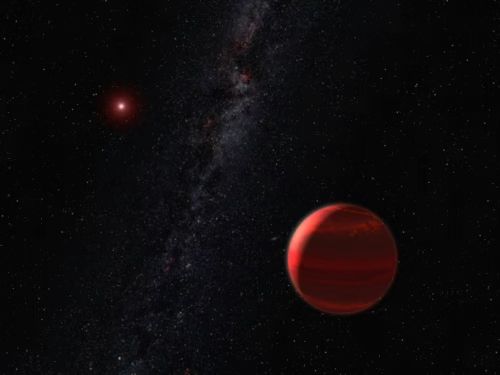Giant Exoplanet Collision: Have you ever wondered what happens when two massive celestial bodies collide in the vast expanses of space? It’s a concept that is as intriguing as it is vast, carrying the weight of unimaginable physical forces and cosmic implications. In recent times, astronomers have uncovered a significant phenomenon — a glowing cloud pointing to a colossal collision between two giant exoplanets. This discovery invites us to explore the multifaceted nature of planetary crashes, broadening our understanding of cosmic events. This article investigates the recent findings, historical examples, and implications of such monumental occurrences on our understanding of the universe.
Table of Contents
Understanding Cosmic Collisions
Unraveling the Event
A young Sun-like star recently became the focus of astronomers’ attention when it demonstrated a sudden spike in infrared luminosity, followed by an extended 500-day eclipse. This was attributed to a massive cloud of gas and dust, indicating the destructiveness of a planetary collision. Using detailed observations from NASA’s WISE mission, scientists discovered that the events stemmed from a collision between two exoplanets. This impact liquified the planets, leaving a molten core encompassed by a gaseous and dusty cloud.
Planetary Collisions in Our Solar System
While exoplanet collisions seem remote, the concept is not entirely alien to our solar system. Historical evidence proposes that our Moon may have formed from a giant impact event. The collision between Earth and a Mars-sized body is theorized to have resulted in the ejection of material, which eventually coalesced to form the Moon. This action aligns with our observations of other cosmic collisions, highlighting them as more than rare occurrences but key factors in planetary formation and evolution.
Historical Context of Cosmic Collisions
The Early Solar System
The young solar system experienced tumultuous events characterized by frequent large-scale collisions. These interactions were pivotal in shaping planetary bodies as we know them. The collision-driven accretion model suggests that planets grew through repeated mergers of smaller bodies, gradually accumulating mass.
Clementine Mission Insights
In 1994, the Clementine mission drastically altered our perception of lunar history. Although the mission primarily aimed to test lightweight technology and sensor performance, it inadvertently led to groundbreaking discoveries about our Moon. Clementine provided the inaugural global multispectral and topographic maps, revealing large quantities of water ice in permanently shadowed lunar craters. These findings illuminated the Moon’s evolution and contributed to hypotheses about the impacts and collisions that once characterized early planetary formation.

Key Concepts and Definitions
Exoplanets and Infrared Luminosity
Exoplanets, or extrasolar planets, are celestial bodies orbiting stars beyond our solar system. Tracking their movements and interactions provides astronomers with valuable insights into cosmic phenomena. Infrared luminosity, the measure of emitted infrared light, serves as a critical tool in identifying and studying these planets. An unanticipated increase in infrared luminosity can signal dramatic events, like collisions, which release massive energy and heat.
Molten Core and Gaseous Clouds
The aftermath of planetary collisions often features a molten core surrounded by gas and dust clouds. As gravitational forces bind the material, the core solidifies over time, potentially giving rise to new planet-like bodies. The gaseous and dusty remnants play a role in redistributing material across the stellar system, influencing the formation of other celestial bodies.
Case Studies of Planetary Collisions
Exoplanet Collision Observation
In a recent study leveraging data from NASA’s WISE mission, scientists observed an extraordinary collision between two exoplanets. The resulting luminous cloud showcased a process of destruction and reformation on a planetary scale. The evidence collected from such collisions is critical in enhancing our understanding of the dynamic processes governing planetary systems, serving as a testament to the forces that shape celestial landscapes.
Theoretical Collisions in our Solar System
The fateful collision hypothesized to have formed the Moon remains a pivotal example, illustrating how cataclysmic impacts can lead to significant outcomes in planetary evolution. Other celestial bodies within our solar system, like Mercury and Mars, also exhibit surface scars and core compositions suggesting a history marked by massive collisions.

Comparisons Across Celestial Bodies
Credibility through Comparisons
When evaluating planetary collisions, comparisons between exoplanetic and solar system collisions provide a balanced view. Data from verified sources, such as the official NASA website, and scientific journals, underpin these comparisons, offering a credible narrative of cosmic events.
| Features | Exoplanetary Collisions | Solar System Collisions |
|---|---|---|
| Observation Tools | James Webb Space Telescope, WISE Mission | Historical Geology, Lunar Samples |
| Frequency | Increasingly observed due to advanced instruments | Previously inferred, observable through geological records |
| Aftermath | Gas and Dust Clouds, Infrared Luminosity | Craters, Moon Formation |
| Scientific Relevance | Expands curren celestial models | Validates historical theories |
| Resulting Impact | Potential new celestial formations | Formation of Moon-like satellites |
Analyzing Different Perspectives
Various perceptions exist regarding the significance and frequency of planetary collisions. Some posit that these events are rare cosmic accidents, while others suggest they are fundamental to the universe’s ongoing and cyclical nature. Understanding these perspectives requires a synthesis of historical data, modern observations, and advanced simulations.
Impact Assessment
The ramifications of such colossal impacts extend beyond the immediate destruction or creation of celestial bodies. They influence the geological and atmospheric evolution of planets, making them pivotal in understanding the broader astrophysical processes. For instance, the materials ejected from these collisions can provide clues to a planet’s internal composition, enhancing comprehension of planetary chemistry.
Future Directions and Predictions
Advancements with New Technology
Future endeavors with the James Webb Space Telescope are set to revolutionize our understanding of cosmic collisions. Building on insights from missions like WISE, these observations promise unparalleled clarity and detail. This new data could redefine existing theories on planetary formations and solar system dynamics.
Long-Term Implications for Society and Science
As evidence of cosmic collisions becomes increasingly compelling, it underscores the delicate balance and interconnectedness within celestial systems. The implications extend beyond planetary science, influencing fields like climate study, geology, and even philosophy. These studies invite society to reflect on Earth’s existence amidst such grand scale interactions and emphasize the importance of protective measures against possible collision threats in the solar system.

Conclusion
In examining the occurrence and implications of giant exoplanet collisions, the narrative unfolds not only through recent discoveries but also via historical contexts and theoretical frameworks. The evidence of past collisions in both exoplanetary realms and our solar system reveals a cosmos in perpetual flux, driven by natural forces beyond our immediate control. As technology advances and observational capacities expand, future studies will likely illuminate deeper aspects of these phenomena, posing fresh questions about our universe’s dynamic nature. What are your thoughts on the potential for such collisions to alter our understanding of the cosmos? Engage with these cosmic mysteries and explore the wealth of information that ongoing research in planetary science continues to unveil.
When Worlds Collide: The Luminous Aftermath of Exoplanet Catastrophe

